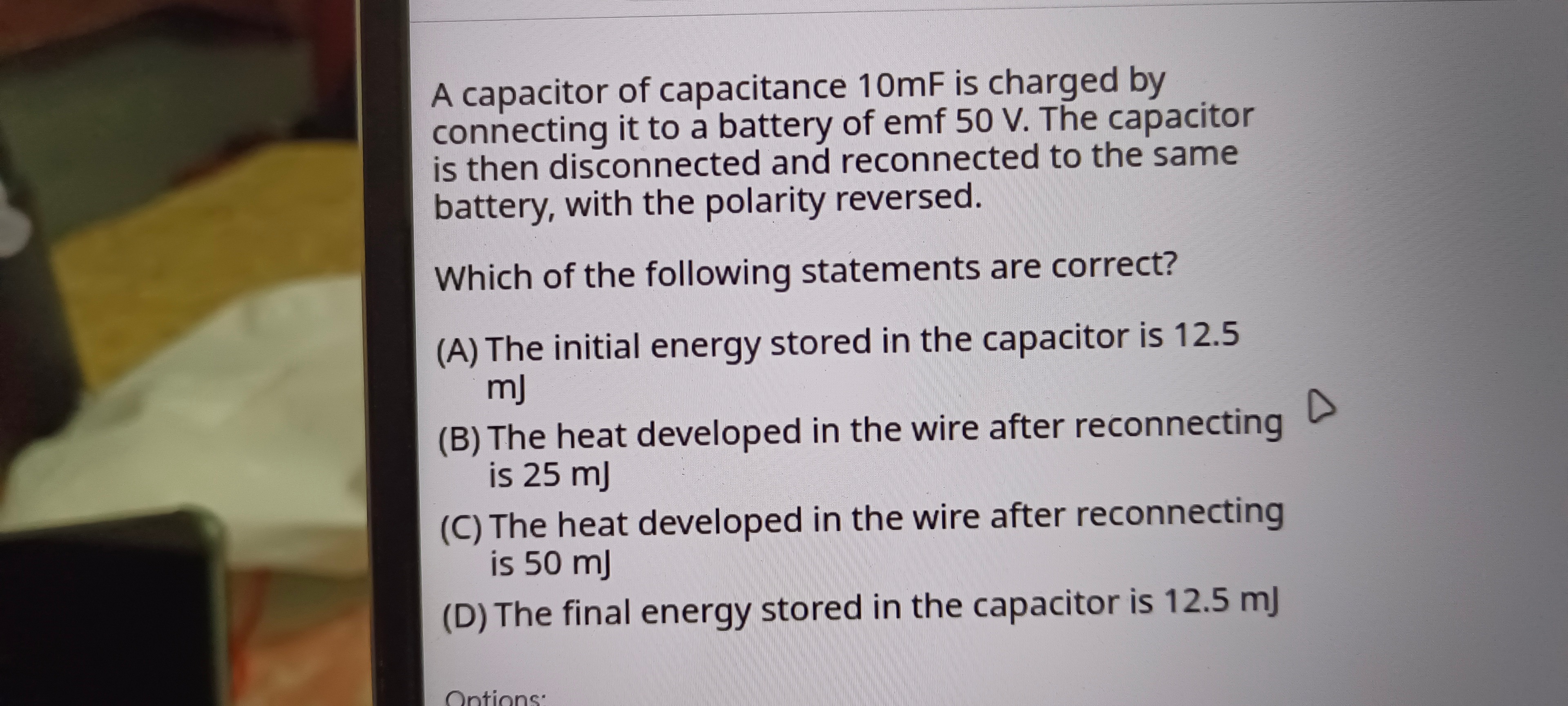Question
Question: A capacitor of capacitance 10mF is charged by connecting it to a battery of emf 50 V. The capacitor ...
A capacitor of capacitance 10mF is charged by connecting it to a battery of emf 50 V. The capacitor is then disconnected and reconnected to the same battery, with the polarity reversed.
Which of the following statements are correct?

The initial energy stored in the capacitor is 12.5 mj
The heat developed in the wire after reconnecting is 25 mj
The heat developed in the wire after reconnecting is 50 mJ
The final energy stored in the capacitor is 12.5 mj
A, C, D
Solution
The problem involves a capacitor being charged, then disconnected and reconnected with reversed polarity. We need to analyze the energy stored and heat dissipated during these processes.
Assumption: The capacitance given as "10mF" is likely a typo and should be "10μF". This is inferred because the options are in milliJoules (mJ), and using 10mF would result in energies in Joules (J), not milliJoules. The similar question also uses microfarads. Therefore, we will proceed with C=10μF=10×10−6F.
Given values:
- Capacitance C=10μF=10×10−6F
- Battery EMF V=50V
1. Initial Energy Stored in the Capacitor (Statement A): When the capacitor is charged by the battery of emf V, the initial energy stored is given by: Uinitial=21CV2 Uinitial=21(10×10−6F)(50V)2 Uinitial=21(10×10−6)(2500) Uinitial=(5×10−6)(2500) Uinitial=12500×10−6J Uinitial=12.5×10−3J=12.5 mJ So, statement (A) is correct.
2. Final Energy Stored in the Capacitor (Statement D): When the capacitor is reconnected to the same battery with reversed polarity, it will again be charged to the same voltage V=50V, but with opposite polarity. The energy stored depends only on the magnitude of the capacitance and voltage, not on the polarity. Ufinal=21CV2 Since C and V are the same as in the initial state, the final energy stored will be the same as the initial energy stored. Ufinal=12.5 mJ So, statement (D) is correct.
3. Heat Developed in the Wire after Reconnecting (Statements B and C): To find the heat developed, we use the principle of energy conservation: Work done by battery (Wbattery) = Change in energy stored in capacitor (ΔU) + Heat dissipated (Hdissipated) Wbattery=ΔU+Hdissipated Here, ΔU=Ufinal−Uinitial=12.5 mJ−12.5 mJ=0. So, Hdissipated=Wbattery.
Now, let's calculate the work done by the battery. The work done by the battery is Wbattery=V×ΔQbattery, where ΔQbattery is the total charge supplied by the battery. Initially, the charge on the capacitor is Qinitial=CV=(10×10−6F)(50V)=500×10−6C=500μC. Let's say one plate has +Qinitial and the other has −Qinitial. When the polarity is reversed, the plate that initially had +Qinitial now has −Qfinal (where Qfinal=CV). So, its charge changes from +CV to −CV. The total charge that flows through the circuit (and thus through the battery) to achieve this change is 2CV. ΔQbattery=2CV ΔQbattery=2×(10×10−6F)×(50V) ΔQbattery=2×500×10−6C=1000×10−6C=1×10−3C=1 mC.
Now, calculate the work done by the battery: Wbattery=V×ΔQbattery Wbattery=(50V)×(1×10−3C) Wbattery=50×10−3J=50 mJ.
Since Hdissipated=Wbattery, Hdissipated=50 mJ. So, statement (C) is correct. Statement (B) is incorrect.
Conclusion: Statements (A), (C), and (D) are correct.
